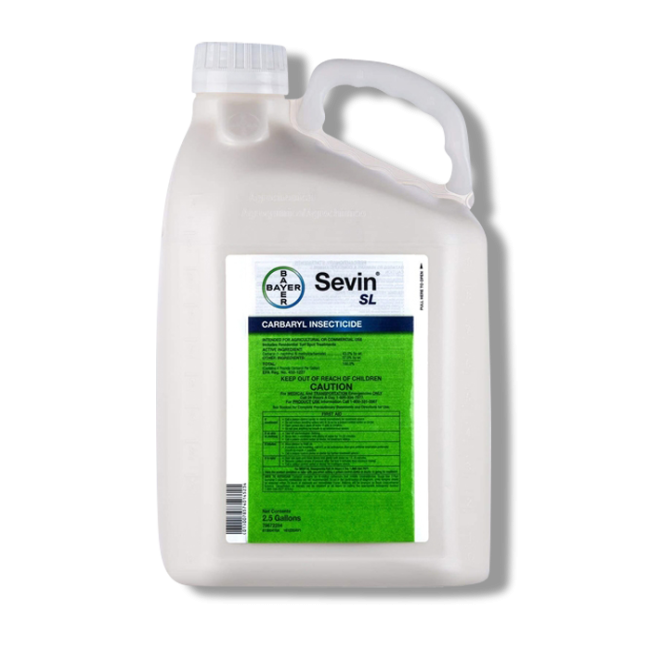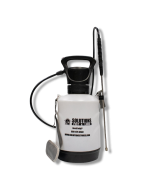Gain access to personalized product screening, the best pricing, rewards, and more!
Sevin SL Insecticide
Sevin SL is an effective broad-spectrum insecticide that controls more than 130 turf and ornamental pests, such as aphids or caterpillars, in agricultural settings, commercial and residential lawns, herbaceous plants, and woody foliage.
Sevin SL, manufactured by Bayer, is a liquid broad-spectrum insecticide that provides residual control for up to 4 weeks of protection from insects and eliminates pests immediately upon contact.
This liquid product contains the active ingredient carbaryl 43.0%, which works to constrict the breath muscles of insects, reducing their oxygen intake and leading to the pest's death.
Sevin SL is an easy-to-use product that readily blooms in the spray tank during application to ensure a wide discharge onto the leaf surfaces of targeted plants.
Tools Needed
You may apply using a sprinkler irrigation system that has a center pivot and solid set. For spot treatments, you will need to use a handheld pump sprayer.
Do not apply by hand, spoon, shaker can, backpack spreaders (front and back mounted), power backpack sprayers, tree injection, and all handheld foggers.
How to Use
- Step 1: Determine how much Sevin SL to use by measuring the square footage of the treatment area. To do this, measure the length and width of the treatment area in feet and multiply them together (length X width = square footage). To find acreage, divide the square footage of the treatment area by one acre (square footage / 43,560 = acreage). Depending on the pest, you will want to use between 1 1/2 to 6 oz. of Sevin SL per gallon of water per 1,000 sq. ft. or 1 to 8 quarts of product per 100 gallons of water per acre of turfgrass. Broadcast applications to turfgrasses may only be made on golf courses, sod farms, cemeteries, and commercial landscapes. Applications to residential turfs may only be performed as a spot treatment. Refer to the label for specific application rates and restrictions for other locations.
- Step 2: Fill the tank of your handheld pump sprayer with half the amount of water, then slowly add the required amount of Sevin SL and the remaining volume of water. Close the sprayer tank lid and continually shake until the solution is well-mixed.
- Step 3: Spray the top and bottom of the leaf surfaces until wet, but not to the point of run-off. Wait until 24 hours after application before watering treated areas or foliage. White grub and European Crane Fly treatments may be watered immediately after spray application.
Where to Use
Sevin SL is ideal for Ornamental Trees and Plants, Turfgrass, Brassica (Cole) Leafy Vegetable Crops, Fruiting Vegetables, Leafy Vegetables, Pasture, and Grasses Grown for Seed, Rangeland, Forested Areas and Rangeland Trees, Noncropland (Conservation Reserve Program; Wasteland; Right-of-Way; Hedgerows, Ditchbanks; Roadsides), Around Building Perimeters, Tree Fruit Crops (Citrus Fruits; Olives; Pome Fruits; Stone Fruits), and Tree Nut Crops (Pistachios; Tree Nuts).
When to Use
Use when pest activity is beginning or has become a nuisance on listed plants. For best results, apply on days when wind speeds are low, and rainfall is not predicted for 24 hours after application to help minimize drift.
Do not apply this product when targeted crops, plants, or weeds are in bloom.
Safety Information
Sevin SL is safe to use around children or pets when applied according to the product label instructions. Always wear the appropriate personal protective equipment (PPE) when mixing or applying this product.
Do not allow children, pets, and other individuals to enter treated areas until 24 hours have passed after application.
For turfgrass sites, the restricted entry interval is 18 days for ornamentals grown for cuttings (cut flowers or cut foliage) where production is in outdoor areas and where average annual rainfall is less than 25 inches a year. The restricted entry interval for olives is 3 days.
Special Considerations
This product will only eliminate pests that are present at the time of application and directly contacted by the product.
| Availability | Online |
| Restricted Use | No |
| Shipping Restrictions | 2.5 Gallon: AK, CA, CT, HI, ME, MI, NY, OR, RI, SC, VT |
| Brand | ENVU (FORMERLY BAYER) |
| Keith's Pro Tips | "Staining may occur on certain surfaces such as stucco, brick, cinder block, wood, fabrics, and carpets. Spray deposits on painted or stained surfaces of finishes (cars, house trailers, boats, etc.) should be removed immediately by washing to prevent discoloration." |
| Product Drawbacks | Sevin SL may kill honeybees and other bees exposed to direct treatment or residues on crops or weeds in bloom. |
| Target Pests | Turf: Annual Bluegrass Weevil, Ants, Armyworms, Bagworms, Box Elder Bugs, Birch, Boxwood and Oak Leafminers, Chinch Bugs, Cutworms, European Crane Fly Larvae, Gypsy Moth Larvae, Leafhoppers, Japanese Beetles (Adult), Lace Bugs, Pine Beetles, Spittlebugs, Sod Webworms, Tent Caterpillars, and White Grubs Ornamentals: Various Adelgids, Aphids, Beetles, Caterpillars, Leafhoppers, Leafminers, Mealybugs, Mites, Moths, Scale insects. |
| Application Equipment | Backpack Sprayer, Gloves, Pump Sprayer, Respirator Mask, Spray Rig |
| Application Methods | Spot Treatment |
| Active Ingredient | Carbaryl 43.0% |
| Product Type | Insecticide |
| Formulation | Suspended Concentrate |
| Application Rate | Depending on the pest, you will want to use between 1 1/2 to 6 oz. of Sevin SL per gallon of water per 1,000 sq. ft.. Depending on the pest, use 1 to 8 quarts of Sevin SL Insecticide per 100 gallons of water per acre of turfgrass. |
| Shelf Life | Sevin SL will last for 3 years when stored in a cool, dry area out of reach from children and animals. Do not store in areas where temperatures frequently exceed 100 degrees Fahrenheit. |
| Yield | 2.5 gallons of Sevin SL will treat up to 10 acres of property when used at the rate of 1 quart per acre. |
| Use Sites | Outdoors |
| Time to Kill | Results from Sevin SL will depend on whether the pest has come into contact with the products material. It will take 4 weeks to witness decrease in pest populations. |
| Comparable Products | Carbaryl 4L |
| EPA Registration # | 432-1227 |
| Restricted Use | No |
|---|---|
| Shipping Restrictions | AK, CT, HI, ME, MI, NY, OR, RI, SC |
| Availability | Online |
| Signal Word | CAUTION |
| Keith's Pro Tip | "Staining may occur on certain surfaces such as stucco, brick, cinder block, wood, fabrics, and carpets. Spray deposits on painted or stained surfaces of finishes (cars, house trailers, boats, etc.) should be removed immediately by washing to prevent discoloration." |
| Target Pests Multi | Glassy-Winged Sharpshooter, Ants, Apopka Weevil, Apple Aphid, Apple Maggots, Apple Pandemis, Apple Rust Mites, Armyworms, Ash Whitefly, Aster Leafhopper, Azalea Leafminer, Bagworms, Balsam Twig Aphid, Bear Tick, Bees, Birch Leafminer, Black Cherry Aphid, Black Grass Bugs, Black Legged Tick, Black Scale, Black Turfgrass Ataenius Larvae, Blister Beetles, Bluegrass Billbug Larvae, Boxelder Bugs, Boxwood Leafminers, Brown Dog Ticks, Brown Soft Scales, Brown Tail Moth, California Orangedog, California Pearslug Pear Sawfly, California Red Scale, Catalpa Sphinx, Centipedes, Cherry Fruit Fly Maggot, Cherry Fruitworms, Chestnut Weevil, Chiggers/Red Bugs, Chinch Bugs, Citrus Cutworm, Citrus Root Weevil, Citrus Rust Mite, Codling Moths, Colorado Potato Beetle, Cooley Spruce Gall Adelgid, Corn Earworm, Crickets, Cucumber Beetles, Cutworms, Cypress Tip Moth, Darkling Beetles, Deer Ticks, Diamondback Moths, Douglas Fir Tussock Moth, Earwigs, Eastern Spruce Gall Adelgid, Eastern Tent Caterpillar, Elm Bark Beetles, Elm Leaf Aphid, Elm Leaf Beetles, Eriophyid Mites, Essex Skipper, European Apple Sawfly, European Chafer, European Corn Borer, European Crane Fly, European Earwig, European Fruit Lecanium, European Pine Shoot Moth, Eyespotted Bud Moth, Fall Armyworms, Fall_Webworms, Fiery Skipper, Filbert Worms, Firebrats, Flea Beetle, Fleas, Forbes Scale, Frosted Scale, Fruit Tree Leafroller, Fuchsia Gall Mite, Fuller Rose Beetle, Gall Midges, Gall Wasps, Grasshoppers, Green Fruitworms, Green June Beetle Larvae, Green June Beetles, Greenstriped Mapleworm, Gypsy Moth, Hackberry Nipplegall Maker, Harlequin Bug, Hickory Shuckworms, Holly Bud Moth, Holly Leafminers, Hyperodes Weevil Larvae, Imported Cabbageworms, Imported Fire Ants, Jackpine Budworm, Japanese Beetle, Jeffrey Pine Needleminer, June Beetles, Lace Bugs, Lawn Moths, Leafhoppers, Leafrollers, Lecanium Scale, Lesser Apple Worms, Lesser Mealworms, Lesser Peach Tree Borer, Lesser Webworm, Litter Beetles, Little Leaf Notcher, Lone Star Ticks, Lucerne Moth, Lygus Bugs, Maple Leafcutter, May Beetle, Mealy Plum Aphid, Mealybugs, Millipedes, Mimosa Webworm, Mormon Crickets, Mosquitoes, Mountain Pine Beetle, Nantucket Pine Tip Moth, Navel Orangeworms, Oak Leafminers, Oak Moth, Oak Skeletonizer, Oakworm Complex, Oleander Caterpillar, Olive Ash Borer, Olive Scale, Orange Striped Oakworm, Orange Tortrix, Oriental Fruit Moths, Oystershell Scale, Peach Twig Borer, Pear Psylla, Pear Rust Mite, Pearleaf Blister Mite, Pecan Leaf Phylloxera, Pecan Nutcasebearers, Pecan Spittlebugs, Pecan Stem Phylloxera, Pecan Weevils, Periodical Cicadas, Pine Looper, Pine Sawfly, Pine Spittlebug, Pitch Pine Tip Moth, Plant Bugs, Plum Curculio, Poinsettia Hornworm, Prune Leafhopper, Psyllids, Puss Caterpillar, Range Caterpillar, Range Crane Fly, Redbanded Leafroller, Redhumped Oakworm, Rose Aphid, Rose Chafers, Rose Slugs, Rosy Apple Aphid, Roundheaded Pine Beetle, Sadded Prominent, San Jose Scales, Sawflies, Scale Insect Crawlers, Scales, Scarab Beetle, Scorpions, Silverfish, Sod Webworms, Sowbugs, Spiders, Spiney Elm Caterpillar, Spittlebugs, Springtails, Spruce Beetle, Spruce Budworm, Spruce Needleminer, Stink Bugs, Subtropical Pine Tip Moth, Tarnished_Plant_Bugs, Tent Caterpillars, Tentiform Leafminers, Thrips, Ticks, Tomato Fruitworm, Tomato Hornworm, Tomato Pinworm, Tussock Moth, Twig Girdler, Variegated Leafroller, Walnut Caterpillar, Wasps, Webworms, Western Pine Beetle, Western Spruce Budworm, Western Tussock Moth, White Apple Leafhopper, White Grubs, Woolly Apple Aphid, Wooly Gall Aphid, Yellow Poplar Weevil, Yellow Striped Armyworm, Yellowheaded Fireworm, Yellow_Scale |
| Time to Kill | Results from Sevin SL will depend on whether the pest has come into contact with the products material. It will take 4 weeks to witness decrease in pest populations. |
| Chemical Type | Insecticide |
| Formulation | Suspended Concentrate |
| Application Methods | Spot Treatment |
| Product Drawbacks | Sevin SL may kill honeybees and other bees exposed to direct treatment or residues on crops or weeds in bloom. |
| Active Ingredient | Carbaryl 43.0% |
| Application Equipment | Backpack Sprayer, Gloves, Pump Sprayer, Respirator Mask, Spray Rig |
| Mix Rate | Depending on the pest, you will want to use between 1 1/2 to 6 oz. of Sevin SL per gallon of water per 1,000 sq. ft.. Depending on the pest, use 1 to 8 quarts of Sevin SL Insecticide per 100 gallons of water per acre of turfgrass. |
| Use Sites | Outdoors |
| Yield | 2.5 gallons of Sevin SL will treat up to 10 acres of property when used at the rate of 1 quart per acre. |
| EPA Registration No. | 432-1227 |
| Shelf Life | Sevin SL will last for 3 years when stored in a cool, dry area out of reach from children and animals. Do not store in areas where temperatures frequently exceed 100 degrees Fahrenheit. |
| Comparable Products | Carbaryl 4L |
| Children or pets? | No |
| Property Characteristics | None |
*Price does not include freight. We guarantee our rate plus shipping will be less than anyone else's price.


















